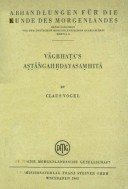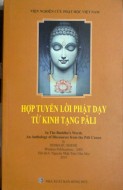Tìm Sách
Sách Tiếng Đức >> Vagbhata’s Astangahrdayasamhita
Thông tin tra cứu
- Tên sách : Vagbhata’s Astangahrdayasamhita
- Tác giả : Clause Vogel
- Dịch giả :
- Ngôn ngữ : Anh
- Số trang : 281
- Nhà xuất bản : Kommissionsverlag Franz Steiner Gmbh Wiesbaden
- Năm xuất bản : 1965
- Phân loại : Sách Tiếng Đức
- MCB : 1210000003509
- OPAC :
- Tóm tắt :
THE FIRST FIVE CHAPTERS 0F ITS TIBETAN VERSION EDITED AND RENDERED INTO ENGLISH ALONG WITH THE ORIGINAL SANSKRIT BY CLAUS VOGEL
PREFACE
After Heinrich Laufer’s Beitrage zur Kenntnia der Tibetischen Medizin (Berlin, 1900) had been for decades the only comprehensive if preliminary work on the topic, the study of Lamaist healing-art has received of late a new and unexpected impulse from three publications, each of which is meritorious in its own individual way: Cyrill von Korvin-Rrasinski’s strictly scientific Tibetiache Medizinphilosophte (Zurich, 1953), Theodor Btjrang’s mainly popular Tibetiache Heilkunde (Zurich, 1957), and Ilza Veith’s richly illustrated Medizin in Tibet (Leverkusen, 1960). What is still a desideratum—though it should properly be the starting-point of any such research—is a complete edition and translation of the rGyud bzi, the standard book of Tibetan medicine, which is supposed to have been adapted from a now lost Sanskrit original by the Kashmirian physician Candranandana about the middle of the 8th century A.D., and which is said to have been written by none other than Kumarajivaka, the famed contemporary of Buddha Sãkyamuni. The indispensable condition, however, of a correct understanding of the rGyud bzi is an intimate knowledge of Tibetan medical terminology, which in its turn can be acquired only by closely comparing an extant medical Sanskrit text of some length with its Tibetan counterpart. No work seems better suited for this purpose than Vagbhata’s Astãngahrdayasamhitã, the only representative description of Indian medicine incorporated into the Lamaist canon.
The plan to bring out a critical edition of the Tibetan Astãngahrdayasamhitã, a specimen of which—along with the original Sanskrit, a literal translation, and a running commentary on the translating-technique—is now placed before the learned public, was conceived in the winter of 1958—59, during a prolonged stay at the International Academy of Indian Culture in New Delhi, where the present writer made a complete transcript of the text from the Peking xylograph: a tedious job that was, however, well paid in the end since the Japanese photomechanical reprint, like the Narthang xylograph, turned out to be difficult to read in many places. It is intended to publish all 120 chapters in Sanskrit, Tibetan, and English and to prepare a trilingual glossary of the medical terminology that may serve, as it were, for a master-key to the locked treasures of Lamaist healing-art.
In concluding, the author wishes to express his sense of obligation to Prof. Dr. Wilhelm Rau for the indefatigable support given at all stages of this work; to Dr. Wolfgang Voigt of the State Library, Marburg, and the staff of the India Office Library, London, for the prompt services rendered in the procurement of urgently needed books; and, last but not least, to Mr. William Fielding Hatton for a stylistic check-up on the Introduction.
Marburg, June 25, 1963 CLAUS VOGEL
CONTENTS
Preface
- Introduction
- Vagbhata’s works in general and the question of their authenticity
- Traditional views
- Cordier’s view
- Jolly’s view
- Hilgenberg-Kirfel’s view
- Vagbhata’s circumstances of life
- His origin
- His date
III. Yagbhata’s Astangahrdavasamhita
- Its commentaries and their authors
- Synopsis
- Arunadatta
- Indu
- Candranandana
- Hemãdri
- Others
- Its later history
- Excerpts and summaries
- Manuscripts
- Editions
iii. Its Tibetan version
- Reason why translated and canonized
- The colophon
- The translating team
- Rin-chen-bzan-po
- Xylographs used for this edition
- Chone
- Derge
- Narthang
- Peking
- Their stemmatical relationship
- Principles followed in this edition
- Corruptions
- Sanskrit variants to be inferred
- Interpolations to be detected
- Remarkable interpretations
- Some aspects of the translating-technique
- Circumlocution
- Redundancy of speech
- Fluctuation of terminology
- Ambiguity of nomenclature
- Incongruity of expression
- Replacement of unsuited words
- Verbalization
- Handling of word-order
- Sanskritisms
- Faithfulness
- First chapter
- Second chapter
- Third chapter
- Fourth chapter
- Fifth chapter
- Bibliography, abbreviations, sigla
- Appendix (to Introd. 4)
 Facebook
Facebook
 Google
Google
 Google+
Google+






